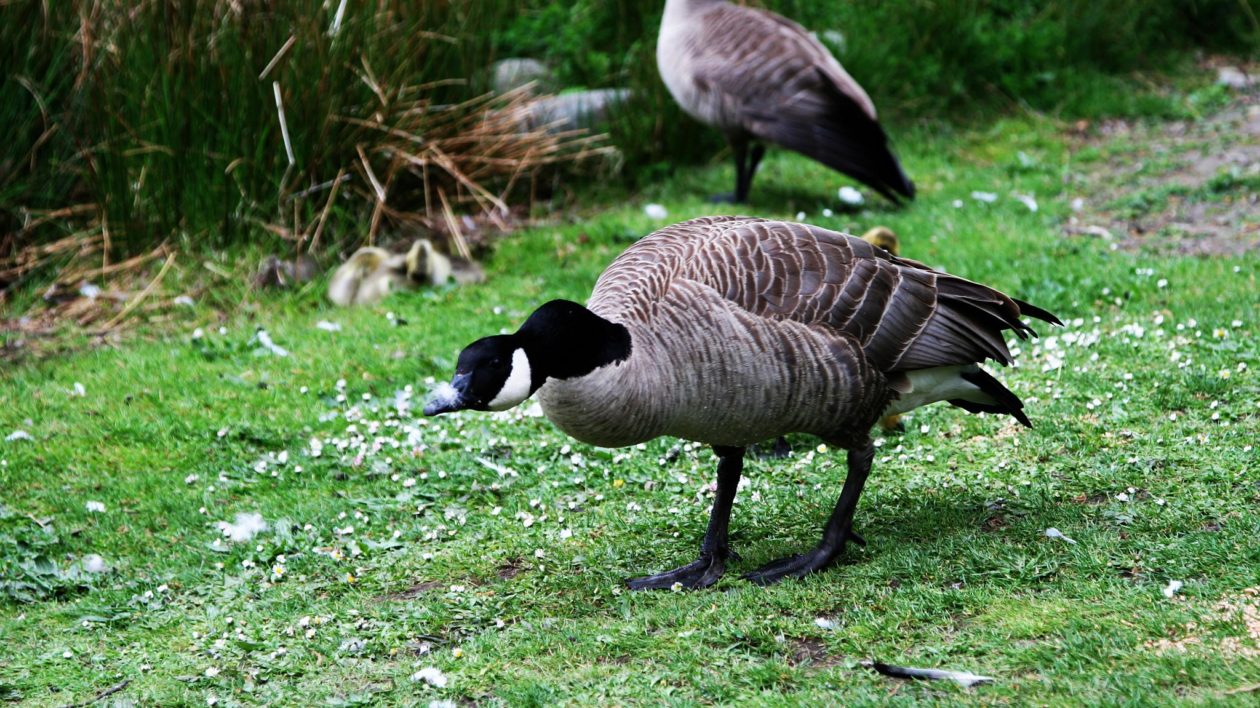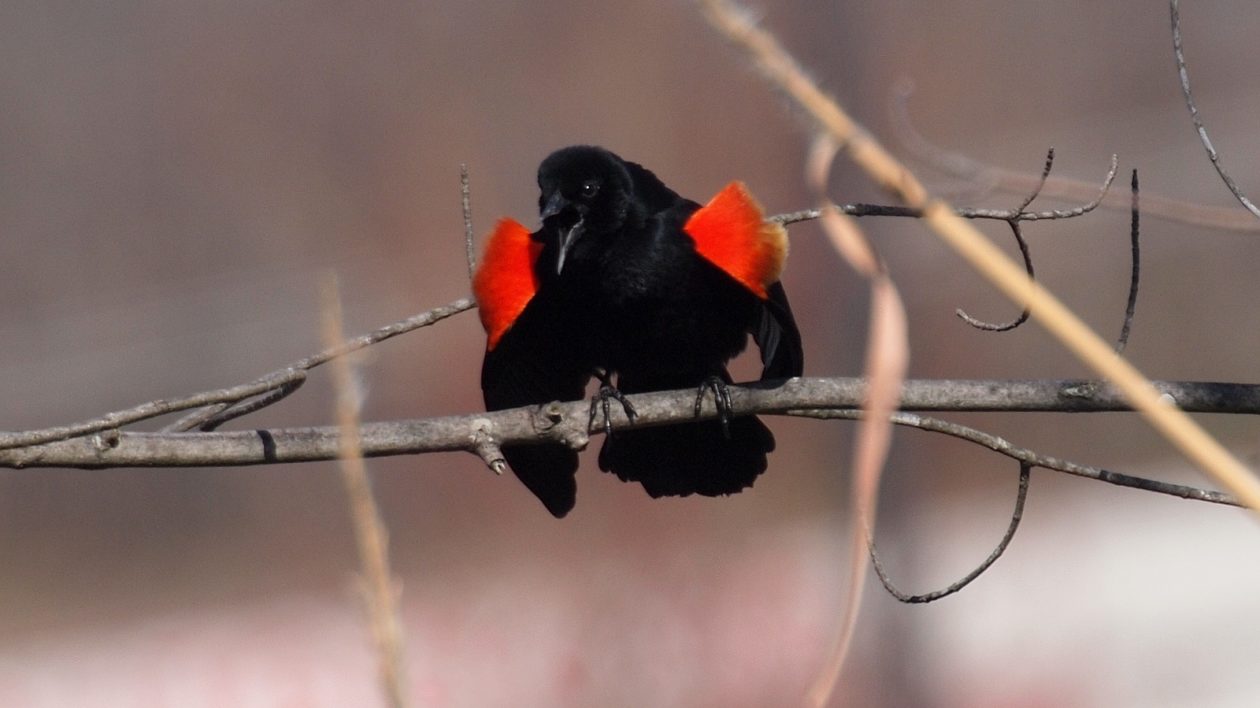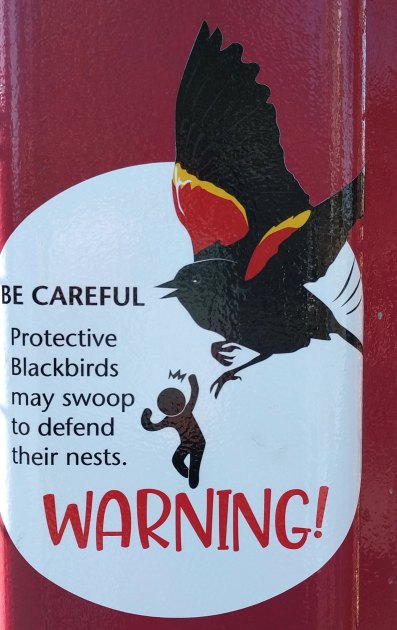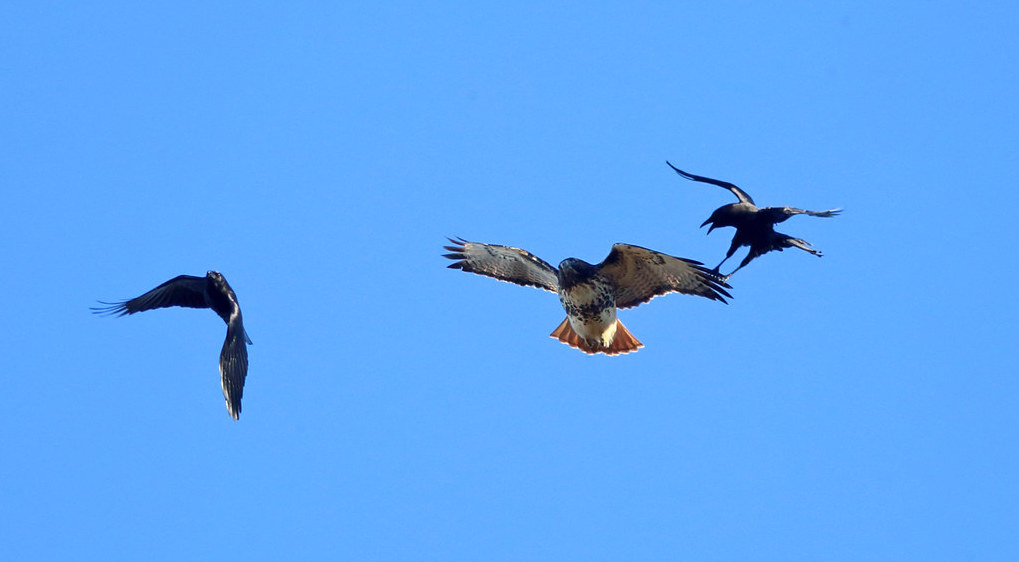Recently, CNN featured a photograph of a blackbird riding the back of a bald eagle, an image the correspondent called “almost too cute to be real.” The story fortunately went on to note that this was not a joyride, but the blackbird driving away an intruder.
While the photo is extraordinary, the behavior is not. I suspect most birders and backyard nature enthusiasts have seen numerous examples of a small bird – or flock of small birds – attacking a much larger and more imposing hawk, owl, or heron.
You may wonder what exactly would prompt a chickadee to take on red-tailed hawk. And, perhaps: how do the little birds survive such antics? Why doesn’t the hawk just grab an easy meal?
Here’s a primer on the avian dramas playing out in your neighborhood.

Defend The Territory
Many bird species are territorial during certain times of the year, and even small birds will fiercely defend their space. The reasons for territoriality vary. Some male birds set up territories to attract mates, and will fiercely drive off any rivals.
Other birds will set up on an abundant food source and become aggressive against intruders. Mockingbirds, for instance, will guard a berry tree in the fall. As Mass Audubon notes, “If there are bird feeders within a mockingbird’s feeding territory, other birds will be driven off, even though the mockingbird has no interest in the food offered at the feeder.”
But most birds are territorial to protect their nests. Birds will aggressively dive bomb any potential predator, large or small. This includes nest raiders like blue jays and avian predators like hawks, as well as cats, dogs and humans.
Even a seemingly innocuous robin can look quite fierce as it squawks and dive bombs your head. One set up a nest just off our back porch this summer, and its attacks were sufficient to deter my young son’s curiosity about the nestlings.
On a spring foray at dusk to try to catch a grass carp in an urban pond (don’t ask), I came a bit too close to a well-hidden Canada goose nest. The female came roaring out of the brush, hissing and flapping. On the terror scale, it may as well have been a grizzly bear.
In Australia, the “swooping season” of Australian magpies is almost a rite of passage, with bicyclists and walkers often subject to dramatic ambushes by these angriest of birds. And while this may be annoying or even scary for a human, it’s no doubt an effective deterrent. It would take a formidable predator to risk the pecking and battering of an enraged mama goose or magpie.

Red-Winged Warning
The red-winged blackbird – the bird photographed “riding” an eagle – exhibits particularly fascinating territorial behavior. Males set up territories where they call and display their red wings. As the Cornell Lab of Ornithology notes, as males mature, their black feathers get glossier and the red wings get brighter. The birds also do a flight display over their territory, flying at slow speed for a more dramatic display. According to the Lab’s publication All About Birds, “Older males secure the highest quality territories and the fittest mates. In experiments, males with blackened epaulets often lose their territories.”
Despite their territorial natures, red-winged blackbirds feed in large flocks in fields. To avoid unpleasant fights at dinner, male blackbirds tuck in their wings and don’t display at these times.

Back at its display ground, a red-winged blackbird will fend off rivals of its own species at its territory, but like many birds, will also drive away just about anything that gets near. Including bald eagles. And humans. Similar to other birds, though, red-winged blackbirds adapt their defensive strategies to the situation.
I frequently run along a greenbelt trail near my home in Boise, going by several blackbird display areas. I’ve never been attacked. The birds see joggers, walkers and bikers all day long. If they dive bombed every human, that’s all they’d do all day (and they’d probably lose their territories to less aggressive blackbirds).
However, I once did a 9-mile summer run along a very rural Iowa road. Judging by the honks and looks of passing cars, jogging was a far less common pastime there. And red-winged blackbirds dive bombed me along much of my route, and with relentless fury. I was large and threatening, and as such needed to be driven out of the territory.
Mob Mentality
Of course, it makes sense that birds would attempt to deter predators close to nests. But you may notice that a small bird (or flock of small birds) often chase and harass large hawks high in the sky, obviously far from any nests. Why?
Ornithologists say that there is a lot going on when birds mob a hawk, owl, heron or other large bird. The very presence of a bird of prey presents an existential threat to the avian neighborhood. As long as that bird’s around, nestlings are not safe. A red-tailed hawk could swoop out of the sky and snatch a baby bird before the parent even knows it’s gone.
The best defense, to invert the old sports cliché, is a good offense. And for small birds, going on the offensive means letting all other birds know that there’s danger overhead. Once the small birds know, they won’t be safe until they drive the danger away.
A mob of small birds makes it difficult for a hawk to hunt. And this is more than just an alarm: The bird sounds are also a call to arms (or…wings?) to all other small birds, regardless of species. The Cornell Lab explains: “The mobbing birds tend to use similar-sounding call notes, regardless of their species, and this may act to recruit other individuals to form a mobbing flock.”
Cornell also notes that this call is one familiar to birders, the “pishing” sound that draws in a variety of species. (It’s also why birders should not over-use this technique, as it can draw birds away from their nests).
Owls also draw bird mobs. At night, nesting birds are relatively defenseless. During the day, they can attempt to mob the owl until it moves away. Crows have a particularly violent reaction to owls, and as the cawing gets louder, more crows get drawn into the fray. I have seen more than 100 mob a single great-horned owl.

Why Don’t the Hawks Just Kill the Smaller Birds?
Let’s face it, a red-tailed hawk versus an American robin is hardly a fair fight. Even a mob of small birds would seem no match for a raptor with sharp talons. And yet small birds routinely chase and even make physical contact with their avian predators.
People witnessing these small bird attacks often ask: “Why doesn’t the hawk just kill the little birds?”
From the ground, it looks like it would be easy.
It isn’t. First, most predators rely on stealth attacks to catch prey. A raptor swoops from above and catches unaware prey. Alert prey is much, much more difficult to catch. This is true whether it is a wildebeest on the Serengeti, or a blue jay in your backyard. A prey species aware of its predator can use a full range of tactics to get away.
Add to this the fact that small birds are just more maneuverable than a large hawk or owl. If you look closely, you will see the small birds darting around, quickly shifting position. It takes a lot of energy for a soaring hawk to catch up to such a bird. This is even more true if the bird is roosting.

If you keep track of your observations, you’ll notice that the songbirds are nearly always mobbing larger predators, birds like red-tailed hawks and ospreys (even though ospreys usually prey on fish). A red-tailed hawk is a threat to nestlings but it’s unlikely to pluck a bird out of the sky.
Mobbing an aerial acrobat like a Cooper’s hawk – a raptor that can quickly negotiate suburban shrubs and trees – is a much riskier gamble. When a Cooper’s hawk is hunting in my neighborhood, the birds still raise the alarm cry quite loudly – but they’ll stay hidden while they do so.
Occasionally, you will see a red-tailed hawk grab a songbird. And great-horned owls will catch the occasional crow. When this happens, the songbird mob goes absolutely bonkers. It’s akin to a referee making a bad call against the home team. The ruckus draws even more birds to the mob.
In short, once a hawk or owl is mobbed by birds, the area is no longer a happy hunting ground. The predator will spend more energy getting prey than it is worth. And while it may not seem like a fair fight, the odds in this instance are stacked in the little bird’s favor.




I have photographed Mississippi Kites harassing Turkey Vultures which seem unlikely adversaries since their forage is so different. Any suggestion as to why this might occur?
Hi there,
I was in a bird outing near Beauvais PP in AB. We had been walking and birding throughout the morning. An osprey was observed, by all, being incessantly chased by a couple of blackbirds. What happened next? The osprey turned over, much like a common raven would do in flight, and nabbed one of those blackbirds in it’s talons. There was a communal ooooooh from the audience. A very memorable birding experience.
Fascinating! This morning i watched a hawk, run around on the ground, in our backyard. It was pecking at the ground for maybe 10 minutes. There were 5-10 small birds darting at it and i thought they were playing. Ha ham I loved your article. It makes me think of our society today. They may be bigger but we are many that need to do more darting. 🙂
Your info is great. I learn so much I would not know otherwise. Keep up the good work keeping us informed!!
Interesting. I’ve seen this behavior many times. My husband & I have had different opinions. Mine being as described. Thank you. He has has asked the question Why not not attack back? Great answer in print from a knowable source.
Terrific piece. We have seen this at play in our own neighborhood, a somewhat pastoral corner of LA.
Thank you.
Years ago when I was getting ready to work the 3-11 shift, I was blow drying my hair with the bathroom window open. Over the noise of the blowdryer I could hear this cacophony of “cawing” fron outside. I turned the dryer off and the noise outside was deafening! The willow tree was full of crows and after perusing the branches, I saw a great horned owl tucked inside the tree. After about 10 minutes of the loudest avian noise I have ever heard, the owl took flight with many of the crows hot on his tail. I have never had another experience like this again, and I will never forget this one!
Fascinating article. Thank you.
I work with an educational western screech owl who lives at the local children’s zoo. She damaged her leg when she fell from her nest as a fluffy little thing and was deemed unreleasable by the vet.
She is trained to the glove and I often bring her home with me. I live in the Santa Cruz mountains among the redwood trees. When we sit outside the stellars jays often gather and scream at her. Given that she is so small –160 grams — and that she is attached to me I’ve often wondered why she feels so threatening to them. You answered the question.
She is completely unfazed by their reaction and given her incredible hearing it must be loud to her.
Ed Engle is the angler essayist who writes a bi-monthly column for our local paper, the Boulder Daily Camera. Though I am not a fisher person, I look forward to his column and read every word — he knows how to tell a story. Your columns share that draw — no matter what you’re writing about, Matt, I’m sure to read it. Thanks for these clear explanations. I’ve often noticed bird behavior that puzzled me, and now my puzzlers have answers.
Jeannie,
Thanks so much for the kind words. It means a lot. And it is especially meaningful to be compared to Ed Engle. When I was in my mid-twenties and having a bit of a professional identity crisis (I was writing about the performing arts which was interesting but not my passion), a very thoughtful coworker bought me Ed Engle’s book Seasonal. It is a wonderful book and at the time I felt it was inspiring but I honestly doubted I would be able to move into the nature writing realm. It is humbling to see his name compared to mine all these years later. Thank you for reading! Matt
It is very informative! Like the pictures and absolutely a wonderful article to read. Love it!
Where US Highway 45 cuts through cat tail overgrown Supples (Soup-lee’s) Marsh coming north out of Fond du Lac, Wisconsin, there are a few miles of running and biking lanes that are reverently avoided by bicyclists and runners each red winged black bird nesting season. Though some of the less experienced nest protecting song birds may dive or even threaten to peck innocent passers through, older, more experienced birds have developed a less strenuous way of defending their territory. Taking advantage of the sun, they have been seen to fly easily over bikers and runners at a height an angle that casts only their shadows in harm’s way over their quarry making themselves seem much larger faster and more menacing.Thusly, they can scare away many more intruders with much less effort. These cute little critters with a most recognizable song are true geniuses in the Avian world.
Very well done!
When I lived in La Mesa, CA, there were many small parrots who would cluster in the trees. There were also a lot of blackbirds. The parrots would “attack” the blackbirds, but it just seemed like play. My son gave me two kittens on Mothers Day. The kittens have brought me many feathers of blackbirds. Eek — even kittens are verocious predators.
A bit different from mobbing as described here, I had a Blue Jay and. red headed Woodpecker stand off one day at my feeder. They stood facing each other. Neither blinked an eye not moved a muscle. They stared, eyeball to eyeball, for several minutes. Finally they departed, each flying away from the other, in opposite directions!